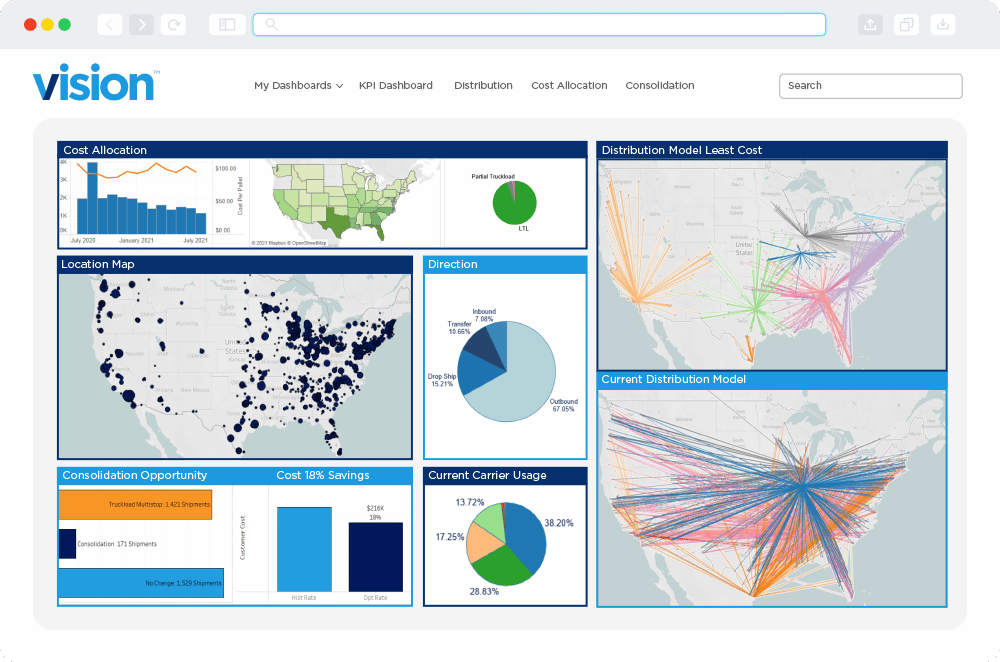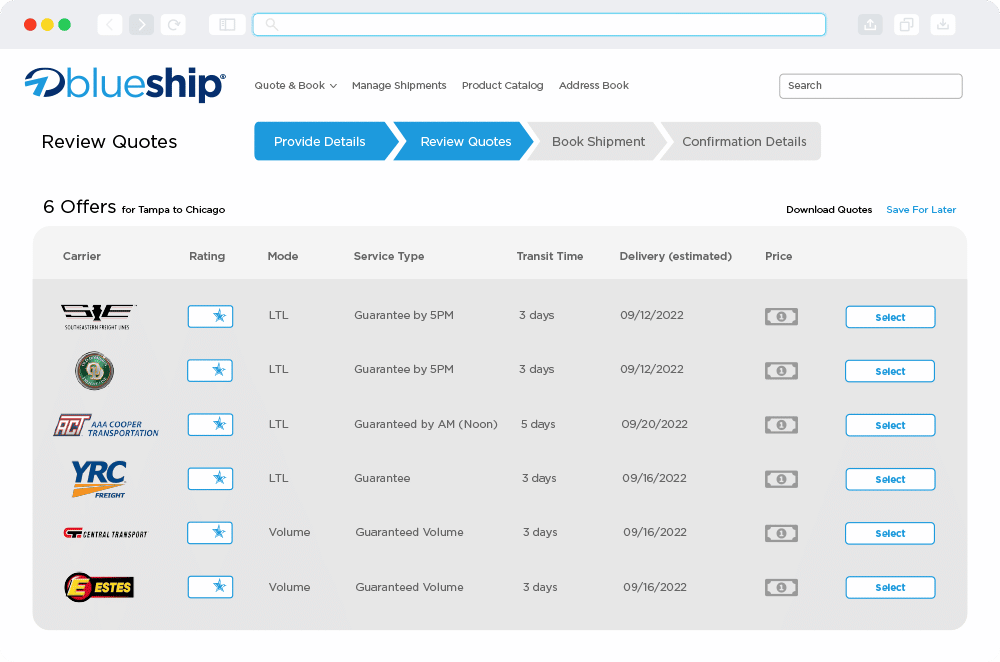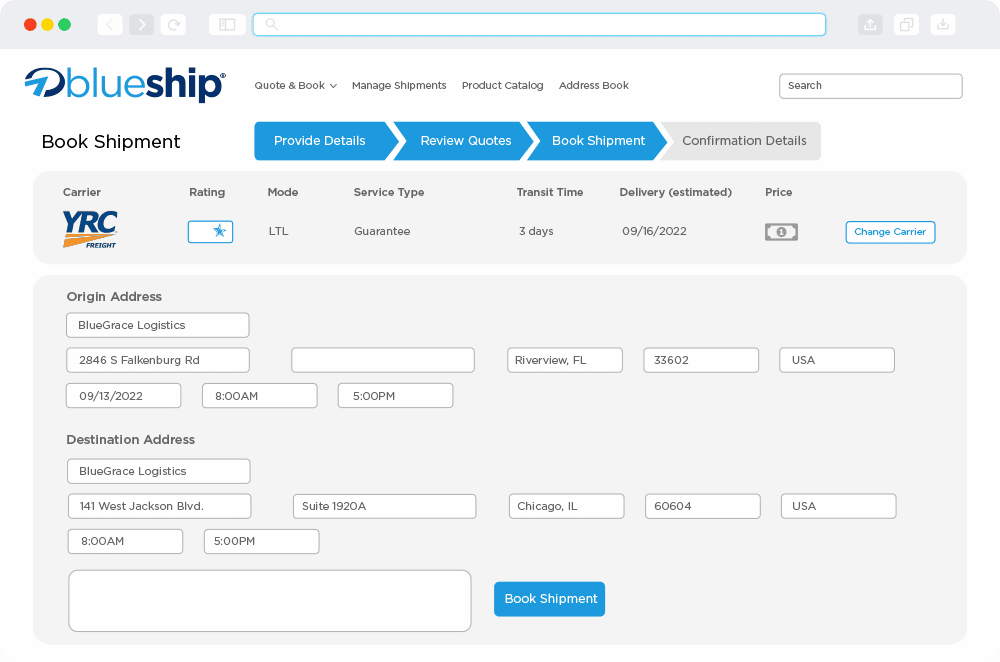
How to Reduce Your Supply Chain’s Carbon Footprint in 5 Easy Steps

Picture a vast network of supply chains, where trucks navigate highways, warehouses buzz with activity, and cutting-edge technology work together seamlessly to keep goods moving. This is the dynamic world that keeps industries running, supplying goods, and fueling the global economy. But it’s also a significant contributor to environmental impacts. That’s where you and your business come in.
In a recent study done by EY, it states that focusing on supply chains is the key to overall environmental, social and governance (ESG) efforts because more than 90% of an organization’s greenhouse gas emissions and 50% to 70% of operating costs, are attributable to supply chains.
In this post, we’ll show you how to proactively reduce your supply chain’s carbon footprint. You’ll not only understand the crucial role supply chains play in sustainability but also be well-equipped with five actionable steps to make a positive change. Ready to roll up your sleeves? We’ll take the complex and make it clear, the challenging and make it achievable, and the eco-friendly and make it profitable. Your supply chain’s carbon footprint is about to get a whole lot lighter.
Step #1: Streamlining Your Supply Chain Tech Stack
In the pursuit of how to reduce your supply chain’s carbon footprint, begin by streamlining your supply chain tech stack. Working toward supply chain sustainability, it’s important to grasp the role of technology optimization.
Interested in Reducing Carbon Emissions for Your Business?
Understanding Your Current Tech Stack:
So, begin by gaining a clear understanding of what comprises your supply chain tech stack. This stack encompasses a variety of technologies and software systems that drive the intricate operations of your supply chain. For example, these tools can include inventory management systems, a transportation management system (TMS), and real-time tracking solutions – the operational backbone of your supply chain.
The Significance of Tech Optimization:
Why does optimizing these technology tools matter so much? It’s all about enhancing efficiency. When your tech stack is streamlined and operating optimally, it results in smoother supply chain operations, fewer delays, and efficient resource utilization. Most important, it contributes to a reduction in carbon emissions. Each improvement in efficiency takes you closer to a more sustainable supply chain.
Efficient Technology Integration:
Efficient integration serves as the bridge that connects these systems, allowing them to work together seamlessly. Think of it as orchestrating a symphony where each instrument plays in harmony with the others. This integration not only enhances efficiency but also holds the potential for significant carbon footprint reduction.
As you take this first step, remember that the key lies in integrating and optimizing your technology stack to enhance efficiency, reduce emissions, and drive cost savings. This sets the foundation for a greener, more eco-friendly supply chain.
Step #2: Minimizing Dwell and Idle Time
Having streamlined your tech stack in step 1, let’s explore the concept of step 2. Grasping the nuances of dwell and idle times is an important aspect of building a more sustainable and efficient supply chain, and here’s why:
Understanding Dwell and Idle Times:
Dwell time is when goods or resources are stationary, often due to facility congestion or unloading delays. However, idle time is when vehicles or equipment are running but not in use, consuming resources without contributing to the supply chain. Recognizing these moments is key to improving efficiency and reducing emissions.
The Environmental and Operational Implications:
Excessive waiting and idleness have implications that go beyond just delays. As a result, these periods impact both carbon emissions and the overall efficiency of your supply chain. Recognizing the connection between environmental and operational aspects is vital.
Effective Strategies for Time Reduction:
After that, we’re ready to dive into strategies for reducing them. Practical approaches can include load optimization, route planning, and real-time tracking. By embracing these techniques, you’ll can make informed decisions that align with your sustainability and efficiency goals.
As we continue toward a more sustainable supply chain, remember that reducing dwell and idle times is a significant step forward. It aligns your operations with sustainability goals while enhancing overall efficiency.
Step #3: Harnessing Intermodal and Multimodal Transit
Building on our understanding of ways to reduce your carbon footprint, we progress to step 3. In this step, we’ll dive into the world of intermodal and multimodal transit, exploring their relevance and potential in supply chain operations.
Grasping Intermodal and Multimodal Transit:
Intermodal transit involves the use of multiple modes of transport, such as road, rail, sea, and air, with cargo being transferred between them using standardized containers. Multimodal transit refers to the combination of different modes of transportation, which can include various combinations of road, rail, sea, and air, often under a single contract. These concepts offer supply chains the flexibility to adapt to changing needs.
Unlocking Potential for Emission Reduction:
So, our focus in this step is on the potential of intermodal and multimodal transit to reduce your carbon footprint. These approaches allow businesses to leverage different transportation modes, choosing the most eco-friendly options for each leg of the journey.
The Power of Combination:
In short, emphasizing how the combination of various transportation modes within a single supply chain can lower emissions and enhance efficiency. This approach enables you to make thoughtful choices regarding the optimal mix of modes to align with your sustainability objectives.
As we dig deeper into creating a sustainable supply chain, understanding and implementing intermodal and multimodal transit can be a game-changer. By combining different modes of transport, you can reduce emissions while simultaneously improving efficiency.
Step #4: Monitoring Carbon Footprint with KPIs
In this step, we’ll look at the pivotal role of KPIs in quantifying and tracking carbon emissions, providing valuable insights into supply chain performance and sustainability progress.
Introducing Key Performance Indicators (KPIs):
KPIs are essential metrics that allow businesses to measure and assess various aspects of their operations. In fact, sustainability KPIs become invaluable tools, providing a comprehensive perspective on your environmental impact and enabling precise carbon footprint measurement, tracking, and improvement.
Specific KPIs for Carbon Footprint Monitoring:
Specific KPIs are particularly relevant when monitoring your carbon footprint. For instance, these KPIs can include measurements like emissions per mile, emissions per unit of product, or emissions per delivery. By focusing on these metrics, you can gain a comprehensive view of your supply chain’s overall environmental impact.
The Power of KPIs in Sustainability:
Beyond numbers and graphs, KPIs invigorate your sustainability initiatives. In sum, they uncover areas where efficiency can be enhanced, emissions can be minimized, and costs can be optimized. KPIs provide clarity in a complex landscape, highlighting not just what’s working but also what needs improvement. As catalysts for change, they empower you to set goals, measure progress, and steer your supply chain towards sustainability.
Armed with an understanding of sustainability KPIs, you’re able to make informed decisions and drive ongoing improvements in reducing your supply chain’s carbon footprint.
Step #5: Reducing Your Carbon Footprint Through Sustainability Reporting
Lastly, building upon KPIs from the previous step, we shift our focus to enhancing sustainability through reporting. Sustainability reporting is not only about showcasing achievements but also enhancing your supply chain’s visibility and impact.
Introduction to Sustainability Reporting:
Sustainability reporting is a critical tool for businesses aiming to elevate their environmental performance. This practice involves transparently communicating your supply chain’s sustainability achievements and commitments, providing valuable insights for stakeholders and enhancing visibility into your operations.
Key Aspects of Sustainability Reporting:
Effective reporting encompasses various components, like environmental impact data, carbon reduction strategies, and alignment with global sustainability goals. By focusing on these aspects, you can effectively communicate your supply chain’s dedication to a greener future.
Leveraging Reporting for Continuous Improvement:
Sustainability reporting goes beyond showcasing achievements; it acts as a catalyst for ongoing enhancements. By regularly reporting on your progress, you demonstrate a commitment to environmental responsibility, inspire stakeholders, and foster a culture of continuous improvement. In addition, collaborating with your 3PL partner offers data-driven insights to reduce carbon emissions and enhance environmental practices, allowing you to quantify progress, set meaningful goals, and navigate your sustainability strategy effectively.
Wrapping Up
From optimizing your tech stack to improving transportation modes and harnessing data through KPIs, this roadmap offers a clear route to reducing your supply chain’s carbon footprint. Furthermore, when you integrate sustainability reporting, it amplifies your environmental commitment.
By implementing these practices, you’ll not only reduce emissions and operational costs, but gain a sustainability competitive advantage. So, take the lead in this eco-conscious era, act proactively, and integrate these strategies to drive a greener, more efficient, and more competitive supply chain.
Interested in reducing carbon emissions for your business? Contact us today! We’d love to chat and help guide your business toward a more sustainable future.




